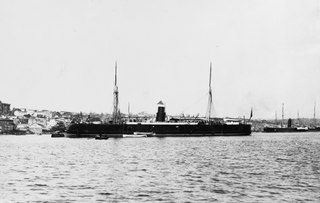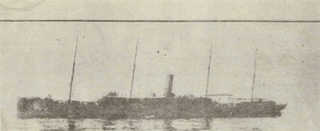
The Battle of Tendra was a naval action fought on 8 and 9 September 1790 in the Black Sea as part of the Russo-Turkish War (1787–1792). It ended in a decisive victory for Ushakov's Russians over the Ottomans.

The naval Battle of (the) Kerch Strait took place on 19 July 1790 near Kerch, Crimea, was a victory for Imperial Russia over the Ottoman Empire during the Russo-Turkish War, 1787-1792.

Feth-i Bülend was an Ottoman ironclad warship built in the late 1860s, the lead ship of her class. The Ottoman Navy ordered her from the British Thames Iron Works, and she was laid down in 1868, launched in 1869, and commissioned in 1870. She was armed with four 229 mm (9 in) guns, was powered by a single-screw compound steam engine with a top speed of 13 knots.
This list includes fleet organisations of the Ottoman Navy during the Balkan Wars.
This list includes fleet organisations of the Ottoman Navy during the Italo-Turkish War.
The Ottoman Military College or Imperial Military Staff College or Ottoman Army War College, was a two-year military staff college of the Ottoman Empire. It was located in İstanbul. Its mission was to educate staff officers for the Ottoman Army.

Asar-i Tevfik was an ironclad warship of the Ottoman Navy built in the 1860s, the only member of her class. She was built as part of a major expansion program for the Ottoman fleet in the 1860s following the Crimean War. Asar-i Tevfik was a 4,600-metric-ton barbette ship armed with a main battery of eight 220-millimeter (8.7 in) guns in a central battery. In 1903–1906, the ship was extensively rebuilt in Germany and a new battery of 150 mm (5.9 in) and 120 mm (4.7 in) quick-firing guns replaced the older weapons.

Mukaddeme-i Hayir was the second of two Feth-i Bülend-class ironclads built for the Ottoman Navy in the 1860s. The Ottoman Navy ordered her from the Imperial Arsenal in Constantinople, and she was laid down in 1870, launched in 1872, and commissioned in 1874. She was armed with four 229 mm (9 in) guns, was powered by a single-screw compound steam engine with a top speed of 12 knots. The ship saw action during the Russo-Turkish War of 1877–1878, but was laid up from 1878 to 1897. At the start of the Greco-Turkish War in 1897, the Ottoman Navy mobilized Mukaddeme-I Hayir and the rest of the ironclad fleet but found almost all of the ships to be in unusable condition. Mukaddeme-i Hayir was disarmed the following year and converted into a stationary training ship in 1911. After the outbreak of World War I in 1914, she became a barracks ship, and served in this capacity until 1923, when she was broken up.

Avnillah was an ironclad warship built for the Ottoman Navy in the late 1860s. The lead ship of the Avnillah class, she was built by the Thames Iron Works in Britain. The ship was laid down in 1868, launched in 1869, and she was commissioned into the fleet the following year. A central battery ship, she was armed with a battery of four 228 mm (9 in) guns in a central casemate, and was capable of a top speed of 12 knots.

Muin-i Zafer was the second of two Avnillah-class casemate ships built for the Ottoman Navy in the late 1860s. The ship was laid down in 1868, launched in 1869, and she was commissioned into the fleet the following year. A central battery ship, she was armed with a battery of four 228 mm (9 in) guns in a central casemate, and was capable of a top speed of 12 knots.

Hifz-ur Rahman was the second of two Lütf-ü Celil-class ironclads built for the Ottoman Navy in the late 1860s. Originally ordered by the Khedivate of Egypt, an autonomous vassal state of the Ottoman Empire, the central Ottoman government forced Egypt to surrender Hifz-ur Rahman while she was still under construction at the French Forges et Chantiers de la Gironde shipyard. The vessel was a turret ship, armed with two 229 mm (9 in) Armstrong guns and two 178 mm (7 in) Armstrong guns, both pairs in revolving gun turrets.

Asar-i Şevket was a central battery ship built for the Ottoman Navy in the 1860s. Originally ordered by the Eyalet of Egypt but confiscated by the Ottoman Empire while under construction, the vessel was initially named Kahira. The ship was laid down at the French Forges et Chantiers de la Gironde shipyard in 1867, was launched in 1868, and was commissioned into the Ottoman fleet in March 1870. Asar-i Şevket was armed with a battery of four 178 mm (7 in) Armstrong guns in a central casemate and one 229 mm (9 in) Armstrong gun in a revolving barbette.

Necm-i Şevket was the second of two Asar-i Şevket-class central battery ships built for the Ottoman Navy in the 1860s. Originally ordered by the Khedivate of Egypt but confiscated by the Ottoman Empire while under construction, the vessel was initially named Muzaffer. The ship was laid down at the French Forges et Chantiers de la Gironde shipyard in 1867, was launched in 1868, and was commissioned into the Ottoman fleet in March 1870. Asar-i Şevket was armed with a battery of four 178 mm (7 in) Armstrong guns in a central casemate and one 229 mm (9 in) Armstrong gun in a revolving barbette.

The Asar-i Şevket class of ironclad warships consisted of two vessels, Asar-i Şevket and Necm-i Şevket, built for the Ottoman Navy in the 1860s. The ships were constructed in France and were based on the design of the earlier ironclad Asar-i Tevfik. The two vessels, built as central battery ships, carried an armament of four 178 mm (7 in) Armstrong guns in a central casemate and one 229 mm (9 in) Armstrong gun in a revolving barbette atop the casemate.

Iclaliye ("Glorious") was a unique ironclad warship built for the Ottoman Navy in the late 1860s and early 1870s. She was ordered from the Austro-Hungarian shipyard Stabilimento Tecnico Triestino, was laid down in May 1868, and was completed in February 1871. The design for Iclaliye was based on the earlier Asar-i Şevket-class ironclads built in France, though she carried a slightly more powerful armament consisting of two 228 mm (9 in) Armstrong guns and three 178 mm (7 in) Armstrong guns. During the Russo-Turkish War she supported Ottoman forces fighting in the Caucasus. She spent most of the rest her career out of service, as the Ottoman Navy was allowed to languish. In 1912, the Navy activated the ancient Iclaliye to help provide artillery support to the forces defending Constantinople. She served in subsidiary roles, including as a training ship and a barracks ship, until 1928 when she was decommissioned and broken up.

Aziziye, named for Sultan Abdülaziz, was the second of four Osmaniye-class ironclad warships built for the Ottoman Navy in the 1860s. The ship was laid down at the Robert Napier and Sons shipyard in 1863, was launched in January 1865 and was commissioned in August that year. A broadside ironclad, Aziziye carried a battery of fourteen 203 mm (8 in) RML Armstrong guns and ten 36-pounder Armstrongs in a traditional broadside arrangement, with a single 229 mm (9 in) RML as a chase gun. Among the more powerful of Ottoman ironclads, the Navy decided to keep the ship safely in the Mediterranean Sea during the Russo-Turkish War of 1877–1878 to preserve the vessel. She spent the 1880s out of service, though she was heavily rebuilt in the early 1890s and converted into a more modern barbette ship. She was nevertheless in poor condition by the time of the Greco-Turkish War in 1897, as a result saw no action, and was disarmed after the war. She saw no further active service, being used briefly as a barracks ship from 1904 to 1909. In 1923, she was sold to ship breakers and dismantled.

Feyzâ-i Bahrî was one of four wooden-hulled Mecidiye-class paddle frigates built for the Ottoman Navy in the 1840s; they were the first Ottoman-built warships powered by steam. She served with the fleet until 1867, including during the Crimean War, where she saw a minor battle with a Russian frigate in the Black Sea. Feyzâ-i Bahrî ferried soldiers to Crete during the Cretan Revolt in 1866 and was converted into a dedicated transport vessel the following year. She served in that capacity until 1878 when she was decommissioned, being broken up in 1880.
Mubir-i Sürur was a steam frigate of the Ottoman Navy built in the 1840s. Originally ordered by the Eyalet of Egypt as Sarkiye, upon completion she was presented as a gift to Sultan Abdulmejid I and was renamed on entering service in the Ottoman fleet in 1850. She had a relatively uneventful career, avoiding any active service during the Crimean War in 1853–1855. She was used to patrol for Greek blockade runners during the Cretan Revolt in 1866, and was reduced to a training ship in 1873. She returned to active service in 1877 following the outbreak of the Russo-Turkish War, during which she was used to ferry Ottoman troops around the Black Sea. The ship remained in service until 1885, when she was reduced to a storage hulk; she was ultimately broken up in 1904.

Tirimüjgan, formerly Pembroke Castle, was a cargo ship launched in 1883 and purchased by the Ottoman Empire from the United Kingdom in 1906, requisitioned as a destroyer tender and used in the Italo-Turkish War, Balkan Wars and served during World War I.